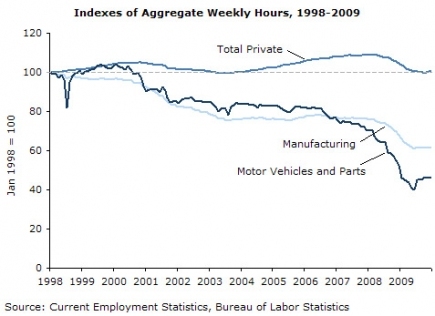
Hours worked fell by 3.8 percent over the decade.
The economy lost another 85,000 jobs in December, driven by continued job losses in construction and manufacturing. While the current data still show a 378,000 job gain for the decade, these numbers will be lowered by approximately 824,000 when the benchmark revision is incorporated into the data with the release of the January employment report. The data show a decline in private sector jobs of 1,549,000 for the decade. The benchmark revision will increase the private sector job loss for the decade to more than 2.4 million.
The index for hours worked shows an even more dismal story. Hours worked are down 3.8 percent for the decade, even before the benchmark revision.
While some analysts had expected a smaller job loss or even a small gain in December, that would have been inconsistent with the recent level of unemployment insurance (UI) claims. UI claims have fallen sharply, but are still averaging over 440,000 a week. The economy did not begin to generate jobs after the last downturn until UI claims had fallen below 400,000 a week. Interestingly, a downward revision to the October jobs numbers led to a reported 4,000 increase in November employment. It remains to be seen whether this will hold up in subsequent revisions, but the difference between a small job gain and small job loss is irrelevant for all practical purposes.
By sector, the data continued to show the same patterns as recent reports. Construction lost 53,000 jobs in December. The job loss was spread across sectors, with the residential sector losing another 18,600 jobs. Job loss in the residential sector will almost certainly stop soon, but it will continue and possibly accelerate in the non-residential sector.
Manufacturing shed 27,000 jobs with the declines spread widely across sectors. The rate of job loss in manufacturing is slowing. Manufacturing employment is likely to level off and possibly even start growing modestly in the next few months.
Retail trade lost 10,200 jobs, all of them in general merchandise stores. It is likely that job losses will continue in this sector, especially in car dealerships, but at a modest pace. The wholesale trade, transportation, and information sectors lost 18,200, 8,000, and 6,000 jobs, respectively.
Health care continues to be a big job gainer, adding 21,500 jobs. The private education sector added 10,800 jobs and the banks are again increasing employment. One bright spot is an increase of 55,700 jobs in employment services. This continues an uptick of employment in this sector and could be a harbinger of future growth in permanent employment.
The picture in the household data was mostly negative. The unemployment rate remained steady at 10.0 percent, but this was only because 661,000 people left the labor force. The employment to population (EPOP) ratio fell by 0.3 percent to 58.2 percent, the lowest level in more than a quarter century. There was a drop in the male unemployment rate from 10.4 percent to 10.2 percent, but this was entirely attributable to a decline in their EPOP of 0.4 percentage points. The unemployment rate for women rose from 8.0 percent to 8.2 percent.
The EPOP for blacks fell by 0.6 percentage points, with black women seeing a 1.2 percentage-point decline. The EPOP for black women is now a full percentage point lower than for white women, reversing a longstanding pattern of higher EPOPs for black women. The EPOP for Hispanics also fell sharply, dropping 0.7 percentage points in December. By education, those without a high school degree were hit hardest, with a 0.7 percentage-point decline in their EPOP. Older workers continued to hold their own, as employment among people over age 55 remained constant, as an increase in 40,000 jobs among older women offset a decline of the same amount among men. All the duration measures hit new records, with the share of long-term unemployed now at 39.8 percent.
This report is consistent with a picture of an economy that is still experiencing job loss, albeit at a much slower rate. Job loss is likely to continue into the first few months of 2010, although even when it turns positive, it is not likely to be fast enough to bring down the unemployment rate.
Our most important fundraising appeal of the year
December is the most critical time of year for Truthout, because our nonprofit news is funded almost entirely by individual donations from readers like you. So before you navigate away, we ask that you take just a second to support Truthout with a tax-deductible donation.
This year is a little different. We are up against a far-reaching, wide-scale attack on press freedom coming from the Trump administration. 2025 was a year of frightening censorship, news industry corporate consolidation, and worsening financial conditions for progressive nonprofits across the board.
We can only resist Trump’s agenda by cultivating a strong base of support. The right-wing mediasphere is funded comfortably by billionaire owners and venture capitalist philanthropists. At Truthout, we have you.
We’ve set an ambitious target for our year-end campaign — a goal of $250,000 to keep up our fight against authoritarianism in 2026. Please take a meaningful action in this fight: make a one-time or monthly donation to Truthout before December 31. If you have the means, please dig deep.